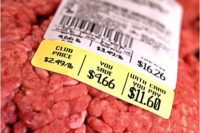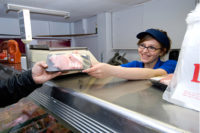The advancements in weighing and labeling technologies haven’t been all that phenomenal in the recent past, according to one processor.
“We’re essentially using the same technology we used five years ago,” he says.
Among smaller and mid-size operations, there appears to be an established mix of manual work along with technology. It sparks wonder as to why some stages of processes haven’t advanced. He believes there’s definitely room for improvement and cites current technology in the marketplace that other industries are using. “We still have a lot of hand labeling although there’s equipment out there that applies labels to boxes and direct prints,” he says.
Is it resistance to change or is it more about cost and investment? When workers are plentiful it’s easy to keep manual processes, well, manual. “I think the cost to refit something is challenging. Our industry is a big industry like any other, and if we can put a person there, let’s put a person there rather than really looking at a return on investment. It’s hard to change because you’re doing it to solve a current issue and not looking for the long-term solution.”
He seems to be describing his niche, and most likely that of others, where tech hasn’t yet seeped into or organized a serious marketing effort toward it. If you’re offering a portion, be it a hamburger or a meatball or whatever, the customer needs so many pieces in a box. “To my knowledge there’s no real good technology out there that offers you a weight and a count. You’ll have a scale system that will give you a weight, but it won’t give you an exact number, so you’re forced to put an extra piece in a box to make up a specific weight. There’s no simple solution that answers both things.”
For some, the count becomes something that’s either done manually or with a separate machine. A combination of weighing and the counting functions sounds like an innovation people would get behind. “If you had a system where they were all tied together and you were able to adjust weight to make sure you were getting the proper count in the box, yeah, that would be a good technology.”
Sometimes carrying on with a process can’t be laid at the feet of stubbornness or antiquated thinking. Sometimes you can’t find what you need from technology. “We looked at in-line printing and couldn’t find a printer that could do our label. And we needed some flexibility to customize our labels because we’re manufacturing other people’s product, too. So we stayed with a printer that printed on adhesive labels.” He says he couldn’t find an automatic applicator to place the labels on the type of carton he needed them placed on. He stuck with the manual system already in place. “With robotic technology, I’m surprised somebody hasn’t introduced a system that’s flexible enough to do random box sizes and different things. It may be out there, and we just didn’t find it.”
At the end of the day, the processor was looking for one solution but was dealing with multiple companies and multiple pieces of equipment to facilitate the things needed to be done. “I don’t think we were doing anything crazy. I just wanted to put information on the box, and I wanted to do it as cheaply as possible.” Again, he argues that there’s not a system flexible enough to be able to do random-sized printing on his cartons and deliver an image clear enough so a scanner can read it. “That just doesn’t make sense to me.” NP





Report Abusive Comment